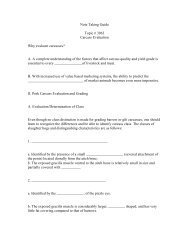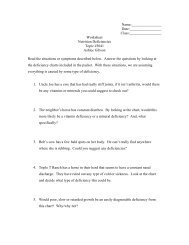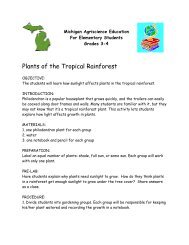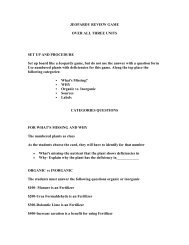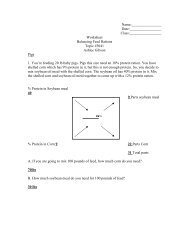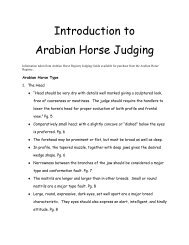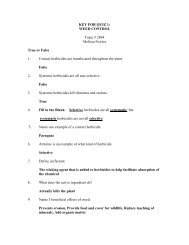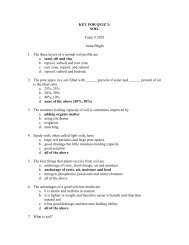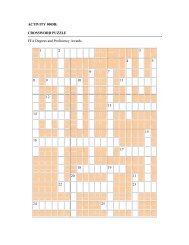Lab 2019A MICROPROPAGATION OF AFRICAN VIOLET PLANTS ...
Lab 2019A MICROPROPAGATION OF AFRICAN VIOLET PLANTS ...
Lab 2019A MICROPROPAGATION OF AFRICAN VIOLET PLANTS ...
- No tags were found...
You also want an ePaper? Increase the reach of your titles
YUMPU automatically turns print PDFs into web optimized ePapers that Google loves.
<strong>Lab</strong> <strong>2019A</strong><strong>MICROPROPAGATION</strong> <strong>OF</strong> <strong>AFRICAN</strong> <strong>VIOLET</strong> <strong>PLANTS</strong>OBJECTIVES: To demonstrate the techniques of laboratory propagation of plants.To determine the comparative effects of various concentrations of auxin andcytokinin on growth and development of African violet plants.To analyze the components of tissue culture media and determine their effects onplant nutrition.BACKGROUND INFORMATION:Tissue culture, the growing of tissue on sterile nutrient media in the laboratory, has greatlyfacilitated research in both plant and animal developmental biology. The media contains vitaminsand sugars for plant growth as well as growth hormones, generally. When plant cells are grown inculture, they initially form a tumor-like mass called callus, but when certain growth regulators arepresent in the media, the cells differentiate to form normal plant tissues. It is possible, therefore,under certain conditions, to grow complete plants from previously undifferentiated tissue.Indole acetic acid (auxin) and cytokinin are but two of several growth regulators. Although eachis needed in growth regulation of the plant, their comparative ratios greatly effect the direction ofgrowth of developing plants. If the two hormones are in balance, i.e. near equal qualities, theculture will form undifferentiated callus; while a large auxin to cytokinin ratio leads to excessiveroot growth. If the auxin to cytokinin ratio is low, shoot will form more prevalently. In either,case, the actual concentrations of the two hormones are very low at 2 mg/L or less.MATERIALS:Construction of a Tissue Culture Hood60 by 80 inch sheet of 2, 3, or 4 mil clear plastic (painter's tarp)bulldog clips (2 to 3-inch length)support frame for hanging file foldersAssembly:Place the file folder frame on a table with its arms facing you.Fold the plastic sheet so it is tow layers thick.Drape the folded sheet with the foldline in front so it overhangs the arms by about two inches.Clamp the sheeting to the top of the arms to form a flat roof.Straighten the sheeting to minimize creases.Spray the inside of the hood and the work surface with 70% ethanol. Dry only the work surface,not the plastic.The hood will look like a lean-to with short curtain valance in front. This fits well on a studentdesk. The overhanging plastic on the sides and back create a larger work area than just the frame.When working, stand over the hood. Don't breathe onto the materials.
Construction of a Tissue Culture Hood (continued)MATERIALS:One set for every two peopleMedia preparation materialsGrowth medium (Murashige/Skoog) obtained from Sigma, 1-800-325-3010(1 liter=40 baby food jars at 25 ml each)Basal medium - no hormones (M 6899)Medium A - auxin present (M 7024)Medium B - auxin and cytokinin present (M 7149)(Each set of two people get two jars of each media)Agar (gelling solution) obtained from SigmaKOH or other base solutions to adjust pH with eye dropperpH meter6 Baby food jars with lids, but need 40 jars for each liter of media madePressure cooker with place to cook onGlass bowl large enough to hold 1 literMicrowave<strong>Lab</strong> activity materialsAfrican violet plant (1 plant for 8-10 people)1 quart mason jar (1 for every 4 people)Sterile distilled water (500 ml)Sterile jam jarDisinfecting solution (Clorox/water, 1:20) (200 ml)70% ethanol in squirt bottle95% ethanol 2/3 full in jam jarScalpel with metal handle and #10 blade2 pair forceps (1 pair 10 inch or longer)1 sterile petri dish (glass or disposable)Paper towelstin foilMasking or duct tape3 Permanent black markersAlcohol lamp, Bunsen burner, or propane flameGermicidal lamp (optional)
PREPARATION PROCEDURES: (Instructor)1. Mix in glass bowl one media type with 1 liter of distilled water.2. Take pH with meter and then add KOH or other base solution until pH is 5.7 + or - 0.1.3. Add 7 grams of agar to solution and stir.4. Place in microwave stirring about once every 2 minutes to keep agar in solution. Mediashould become very close to clear in color. This indicates that the agar is completelydissolved in solution.5. Place 25 ml of media in each baby food jar. BE CAREFUL <strong>OF</strong> HOT LIQUID.6. Place lids on jars but not tightly and make sure to label jars as to the media type.7. Repeat steps 1-6 for each media.8. Fill the needed number of quart mason jars with distilled water (only fill ½ - 2/3 way full)and place tin foil over tightly fastened with thin wire around mouth of jar.9. Cover empty jam jar with foil similar to quart jar.10. Take ½ inch stack of paper towel (enough for 8 students) and place in tin foil. Rap verywell as to seal the paper towels so that they will not get wet in the pressure cooker. Usemasking or duct tape to seal.11. Rap instruments (forceps and scalpels) and also petri plate if glass in tin foil similar topaper towels.12. Place media, water in mason jars, jam jars and foil packets with instruments, petri platesand paper towels in pressure cooker. Try to keep the foil packets on top to reduce thecontact with water. May need to use pressure cooker more than once to get all materialssterile. Follow directions to pressure cooker. Pressure cook for 30 minutes on high.13. Let cool till pressure is low and remove. Place materials in clean (dust free and low airmovement) room until lab exercise.14. Make sure just before lab that the Clorox solution (may use any type of Chlorine basedbleach) and 70% ethanol are mixed and ready to be used.LAB PROCEDURES:Although the materials listed above are for pairs, you should work in groups of four. Each studentwill have three baby food jars cultured at the end of the experiment.
Choose a room to work in that does not have much air movement or dust because ofcontamination problems. It may be beneficial to use plastic coverings over tables.May want to use germicidal lamp near plates and jars to reduce contamination.1. Wash hands with soap, clean under nails.2. Spray both surfaces of the African violet plant with 70% ethanol.3. Select a healthy appearing upper African violet leaf and remove it from the plant.4. Place the cut leaf in a sterile jam jar and cover it with the Clorox solution for twominutes.5. Pour off the Clorox and rinse with 3 separate changes of sterile distilled water.6. Place the disinfected leaf in a sterile petri dish.7. Pass the scalpel blade which was resting in the ethanol through the flame making sure theblade is pointing downward so that alcohol does not burn fingers. Partner holds the petridish lid at an angle over the leaf. Avoid including large leaf veins in the cut sections.OPTIONAL: Cut one more leaf square. Accurately measure the size of this section.Consider this section to be 2 mm thick and compute it's volume.8. Open baby food jar and flame the opening of the jar.9. Using long forceps, transfer a leaf section to each of the 6 baby food jars (3 for eachstudent). Flame the opening of the jar and cap it tightly immediately after the transfer.10. <strong>Lab</strong>el each tube with your name, media treatment and date.ADDITIONAL LAB NOTES:1. Work in an area of little air movement. Sterilize work surfaces.2. Do not lean over the culture tube, work with it out in front of you.3. Flaming the instruments burns off the alcohol, do not hold the instrument in the flame.Allow the instrument to cool before using it.4. Keep flames away from open containers of alcohol. If an alcohol beaker becomesinflamed simply cover it with a petri dish or similar. So not touch the beaker.5. With an open culture work quickly but carefully to reduce exposure to air.6. When using African violets each section used must contain a portion of a vein.7. Temperatures throughout the growth period should be fairly constant at about 23 to 27degrees Celsius (74 to 80 degrees Fahrenheit).8. Diffuse artificial or window light is best. Do not expose culture tubes to direct sunlight.9. Growth to new individual plants begins as "bumps" appear on leaf sections in 5-8 weeks.Complete plants may be transplanted into sterile African violet potting soil after 3-4months. Gently scrape excess agar from the roots and keep the young plants moist.OBSERVATION OPTIONS:Do not be alarmed to get 50% contamination within the jars.1. Count and measure roots and shoots and compare treatments after getting an average ofeach treatment.2. Calculate volume of jar to volume of growth.3. Sight observations on health of plants.
SUGGESTED USES:plant physiologyplant nutritionhormonesbiochemistryanimal and plant differencescell physiologygrowth and developmentreproductionCULTURE TUBES:number 1 2 3color ________ __________ ____________contents ________ __________ ____________condition ________ __________ ____________REPORTING SUGGESTIONS:1. Observations only.2. Record observations weekly using the following legend:v = callus i = increase in sizer = roots d = decrease in sizes = shoots nc = no changet = death c = contaminationObservations could be recorded in chart patterned after above and dated.3. Volume comparisons. After carefully rinsing all growth media from the tissues, use agraduated cylinder to measure the volume displacement of each type of tissue.



